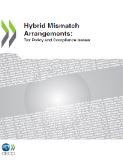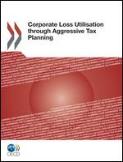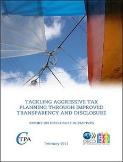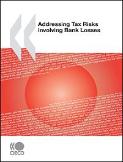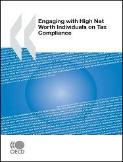Aggressive tax planning
Publications
|
The OECD undertakes research and analysis as part of its ATP work, and makes recommendations to tax administrations on how to identify and respond to aggressive tax planning. |
||
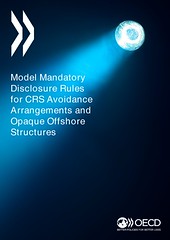 |
Model Mandatory Disclosure Rules for CRS Avoidance Arrangements and Opaque Offshore Structures This publication contains the Model Mandatory Disclosure Rules for CRS Avoidance Arrangements and Opaque Offshore Structures. The design of these model rules draws extensively on the best practice recommendations in the BEPS Action 12 Report while being specifically targeted at these types of arrangements and structures. Part I gives an overview of the model rules. Part II sets out the text of the rules. Part III provides a commentary on those rules. |
|
 |
Neutralising the Effects of Branch Mismatch Arrangements This 2017 report sets out recommendations for branch mismatch rules that would bring the treatment of these structures into line with the treatment of hybrid mismatch arrangements as set out in the 2015 Report on Neutralising the Effects of Hybrids Mismatch Arrangements (Action 2 Report). Branch mismatches arise where the ordinary rules for allocating income and expenditure between the branch and head office result in a portion of the net income of the taxpayer escaping the charge to taxation in both the branch and residence jurisdiction. Unlike hybrid mismatches, which result from conflicts in the legal treatment of entities or instruments, branch mismatches are the result of differences in the way the branch and head office account for a payment made by or to the branch. The 2017 report identifies five basic types of branch mismatch arrangements that give rise to one of three types of mismatches: deduction / no inclusion (D/NI) outcomes, double deduction (DD) outcomes, and indirect deduction / no inclusion (indirect D/NI) outcomes. This report includes specific recommendations for improvements to domestic law intended to reduce the frequency of branch mismatches as well as targeted branch mismatch rules which adjust the tax consequences in either the residence or branch jurisdiction in order to neutralise the hybrid mismatch without disturbing any of the other tax, commercial or regulatory outcomes. The annexes of the report summarise the recommendations and set out a number of examples illustrating the intended operation of the recommended rules. |
|
 |
BEPS 2015 Final Reports The OECD presented the final package of measures for a comprehensive, coherent and co-ordinated reform of the international tax rules to G20 Finance Ministers at their meeting on 8 October, in Lima, Peru. The OECD/G20 Base Erosion and Profit Shifting (BEPS) Project provides governments with solutions for closing the gaps in existing international rules that allow corporate profits to « disappear » or be artificially shifted to low/no tax environments, where little or no economic activity takes place.
|
|
 |
BEPS 2014 Deliverables
Addressing base erosion and profit shifting is a key priority of governments around the globe. In 2013, OECD and G20 countries, working together on an equal footing, adopted a 15-point Action Plan to address BEPS. This is the first set of reports and recommendations which address seven of the actions in the BEPS Action Plan.
|
|
|
|
Aggressive Tax Planning based in After-Tax Hedging
|
|
|
|
This report describes the most common types of hybrid mismatch arrangements (i.e. arrangements exploiting differences in the tax treatment of instruments, entities or transfers between two or more countries) and the effects they aim to achieve. It summarises the tax policy issues raised by these arrangements and describes the policy options to address them, with a focus on domestic law rules which deny benefits in the case of hybrid mismatch arrangements and countries’ experiences regarding their application. The report concludes that the same concern that exists in relation to distortions caused by double taxation exists in relation to unintended double non-taxation and recommends a number of actions to be undertaken.
|
|
|
|
Corporate Loss Utilisation through Aggressive Tax Planning This report describes aggressive tax planning issues surrounding corporate losses. It describes the size of loss carry-forwards, the rules applicable in relation to losses, and identifies the following risk areas: corporate reorganisations, financial instruments and non-arm’s length transfer pricing. After having summarised aggressive tax planning schemes on losses, as well as country detection and response strategies, it offers a number of conclusions and recommendations for tax administrations and tax policy officials.
|
|
|
|
Tackling Aggressive Tax Planning through Improved Transparency and Disclosure Aggressive tax planning is a major risk to the revenue base of many countries. Countries have developed a number of strategies to deal with aggressive tax planning. The underpinning of any such strategy is to ensure the availability of timely, targeted and comprehensive information, which traditional audits alone can no longer deliver. This report covers a range of approaches from mandatory disclosure rules to forms of co-operative compliance. It provides a toolkit for those concerned with aggressive tax planning and recommends a careful review of the different approaches to inform both tax policy and compliance.
|
|
|
|
Addressing Tax Risks Involving Bank Losses Bank losses as a consequence of the recent financial and economic crisis are huge. This report provides an overview of the tax treatment of such losses in 17 OECD countries and describes the tax risks that arise in relation to bank losses from the perspective of both banks and revenue bodies. It outlines the incentives that give rise to those risks, including incentives related to the regulatory capital treatment of accumulated tax losses accounted for as deferred tax assets. In addition, it describes the tools revenue bodies have to manage these potential compliance risks and concludes with recommendations for revenue bodies and for banks on how risks involving bank losses can best be managed and reduced.
|
|
|
|
Engaging with High Net Worth Individuals on Tax Compliance High Net Worth Individuals (HNWIs) pose significant challenges to tax administrations due to the complexity of their affairs, their revenue contribution, the opportunity for aggressive tax planning, and the impact of their compliance behaviour on the integrity of the tax system. This publication examines in detail this taxpayer segment, describes their usage of aggressive tax planning schemes and proposes prevention, detection and response strategies that tax administrations can use to respond to these challenges. It also addresses aspects of voluntary disclosure initiatives for past non-compliance that may be particularly pertinent in the current environment. |
|
Related Documents

